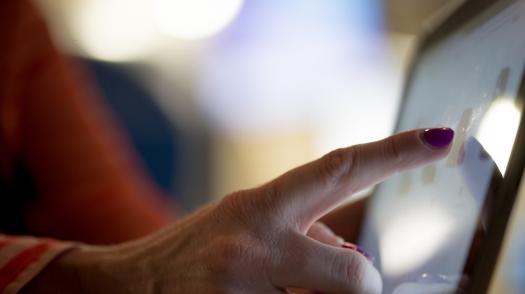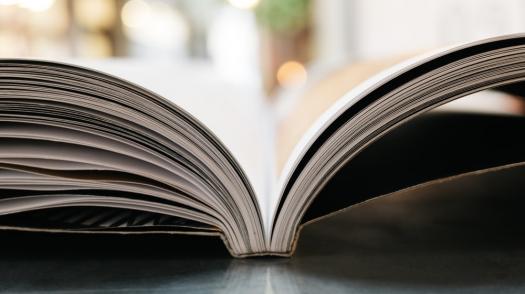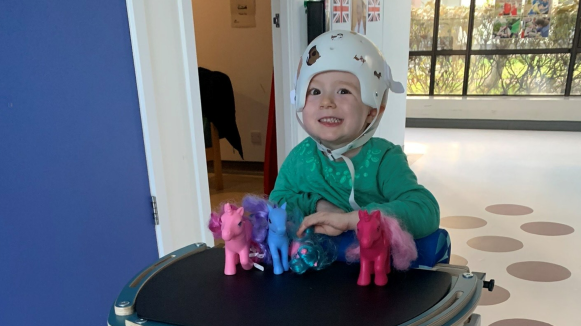When a baby or infant sustains a brain injury the impact it has on them may be different to that of an older child. In this section you will learn more about the differences and some tips and ideas in overcoming many of the common challenges.
Causes of brain injury in infants
Evidence says that most head injuries in infants and toddlers occur due to falls at home1, 2. Other common causes of head injury in young children are from car crashes or during playground activities2. Brain injuries in this age group can also have non-traumatic causes such as a stroke3, 4 or meningitis.
Brain injury can occur in the very early days of a child's life and can be as a result of complications at birth. In cases like this, it is not uncommon for the child to be diagnosed later with cerebral palsy3 (a neurological condition that affects movement and coordination).
Research shows that up to 19% of brain injuries in this age group of babies and toddlers are due to a non-accidental injury5.
No matter how they sustained their injury, every baby or toddler's diagnosis may vary depending on what services the family are accessing. As mentioned above, your child may be diagnosed with cerebral palsy if they sustained their injury in the very early days after being born.
We often think of cerebral palsy as occurring in the womb or during the baby’s birth but the actual definition is an ‘injury to the developing brain’ which could include a brain injury which occurs in the first couple of years of a child’s life3.
Advice on concussion or mild brain injuries in babies and infants
For more information on concussion, please see our section on Concussion in infants and toddlers.
CanChild has developed this printable leaflet that explains more about mild head injury and concussion in babies and infants. It gives advice about preventing head injuries, what to look for, and the action to take2.
Do younger children cope with a brain injury better than older children?
There is no clear answer and that is because the experts don’t always agree6, 7.
One argument is that younger children aren’t as far along in their development. So their injury might ‘interrupt’ them while they are still learning. And they may not have as many skills or as much experience to cope with their injury8.
We also know a brain injury can make picking up new skills difficult.9, 10 This may make it more difficult for a younger child to learn the skills an older child may already have under their belt11.
But this isn’t the only view. Some researchers believe a younger brain is more ‘plastic’ and better able to find new ways of doing things6.
To make things even more complicated, it’s very difficult to work out from just one ‘strand’ of brain injury – such as a child’s age – how that child will be affected.
There are lots of other things to consider, like how severe the injury is6, how much rehabilitation there is, and a child’s home environment7. But there is one thing that many researchers agree on: the importance of a child’s family environment in their recovery12, 7.
Fatigue
Most of us are familiar with tiredness of the body. But children with an acquired brain injury often also experience a different kind of tiredness - 'fatigue'13. Fatigue can have an effect on a child’s mind and senses as well as their bodies14, 15. It can be harder to spot in babies and young children, as we expect them to take naps as part of their daily routine.
Difficulty settling to sleep or staying asleep, needing longer naps, irritability and poor feeding could be indications of fatigue. Reducing environmental demands and managing daily activities can often bring improvements in energy levels.
Give time to rest16; don’t feel that every moment needs to be filled with activity. It is important to build in rest times when the child is away from home for a longer time. For example, at a family event make sure you give them ‘time out’ to relax somewhere quiet away from everyone else.
Manage appointments by trying to spread these out evenly over a week.
Increased irritability can be an indication that a child is having headaches – a young child may not be able to tell you this, so looking at behaviour patterns and expressions can be helpful.
Routine
Some children with acquired brain injury struggle with switching between different things17. By establishing set routines, such as keeping regular bed times and mealtimes, a child has less 'thinking' to do. They can focus on one thing, and the hope is that activities become ‘automatic’ and simpler to carry out.
It’s also thought that these routines make children more at ease. Through them, children are given familiarity, and fewer opportunities to get things wrong (which can have an effect on their self-esteem)18.
While routine is often a usual part of caring for a baby or young child, it is even more important following ABI. Mealtimes in particular may benefit from being extremely regular, in the first instance.
A visual timetable or ‘now and next’ pictures can be helpful for toddlers to know what is coming up during the day.
Sensory problems
An acquired brain injury can affect the way children process what’s going on19 and they may easily feel overwhelmed by noise or a busy environment.
A young baby is usually unable to indicate when they are feeling overwhelmed – but it may be a sign when they are more upset, irritable, quieter or more withdrawn. Quieter places with fewer distractions can help. Avoid sensory ‘overload’ by remembering that even a trip to the supermarket can be overwhelming.
When concentrating on one particular activity eg feeding, it may be helpful to eliminate other distractions, for example, turning the TV off, withdrawing to a quiet area when out, feed when other children are elsewhere or occupied.
Daily playtimes are important; if possible spend one to one time with your child in a quiet environment. Basic play as well as developmental play is important as it gives opportunities to learn and develop. It is important to also balance this with the child’s energy levels and need for rest.
Bedtime routine
Adults with traumatic brain injury commonly have difficulties with sleep, and it is thought children may experience the same problems. These might include getting off to sleep, disturbed sleep or difficulty waking up properly in the morning20.
Clear bedtime routines are important for babies and young children and especially important after a brain injury.
Make sure you give them longer than you might expect to wind down. This can include story time and bath time. Try turning off stimulating activities such as the TV or computer at a regular time each day.
Other good ways to encourage a healthy sleeping pattern21:
Try not to let your child overdo it during the day. It might sound like it doesn’t make sense, but being too tired can actually make it more difficult to sleep.
Try to keep regular hours. Get your child to bed each night and get them up around the same time each day, if possible.
Try to make their bed and your bedroom somewhere they go only when they want to sleep.
Avoid sugary drinks such as hot chocolate and try milk instead.
Talking to your child about brain injury
It can be helpful to talk to your child about what has happened as they may not feel like ‘themselves’ but may not be able to explain this and this can have an impact on their wellbeing22. This can be particularly helpful with toddlers, where you notice changes in behaviour.
Our picture book ‘Heads Up Tim-Tron’, which can be ordered for free and comes with an audio and parents’ guide is one way in which you can start the conversation about brain injury.
You may also be able to pick up some tips from our ‘talking to a child after brain injury’ page.
Increasing activity
Use irritability, tiredness and developmental progress as guides to increase activity: if a child still has altered sleep and behaviour patterns, and is maintaining developmental levels, this may be a sufficient amount of activity for the present time.
When sleep and behaviour improves, and you notice some developmental progress, try to increase activity levels.
For more information on returning to normal activity, Can Child’s "Return to Activity" brochure leaflet will give you more information.
Development following acquired brain injury
As babies and infants get older they will develop new skills and learn new things such as smiling for the first time, taking their first steps, and speaking their first words. You may hear these being referred to as developmental milestones23.
It is important to know what the normal developmental milestones are for children at each age but also to remember that every child is unique.
The ages given for achieving each milestone are average for all children so a lot of children may meet different milestones earlier or later24.
If your child is not learning new skills, meeting milestones or their progress slows down after the acquired brain injury you should talk to your health visitor who can organise developmental assessments if required. Following these assessments they may be referred for therapy or to a paediatrician.
Expectations and parent support
For children who sustain a brain injury from a very young age parents want to know how “bad” it is from the outset and whether their child will meet milestones. These questions can be difficult to answer, particularly for healthcare professionals with limited experience of children with the condition.
It is helpful for parents or carers and healthcare professionals to work together in a partnership as the child continues to get older. This helps with sharing information, which can help with making decisions.
These professionals should be able to explain the developmental milestones of children and give you advice as to whether they think your child is or isn’t meeting these and working towards the next steps.
Brain injury can have a huge psychological effect for parents of children who have received their injury as a baby, as they may be unsure how much of an impact it will have on their child.
As babies’ brains are not fully developed yet, even a mild brain injury may result in difficulties or impairments that may develop some years later.
When it comes to the prognosis of infant brain injury, there is never a set or fixed answer as this type of injury covers a wide spectrum.
As brain injuries are complex and no two injuries are the same, a proper prognosis for a baby or toddler may take months or years. There are several things that doctors and other health professionals assess and evaluate to get a general idea of the prognosis.
It is helpful to keep in touch with your child’s GP and record dates and details of any behaviour you think might be a sign that your child is not meeting their milestones.
Parental values and goals can form an important component of the rehabilitation programme that is created for a child. Goal setting should be a joint venture between parents and healthcare providers.
Brain injury can lead to long term effects; parents will have questions and issues to resolve throughout their lives. Continuity in the relationship between parents and trusted counsellors is important; professionals such as family doctors and therapists are people who should listen, support, advocate, and be there when challenges arise25.
Challenges are especially likely at times of transition in the life of the child and family, such as at the time of starting primary or secondary school and leaving school. Continuous and consistent service is valued by parents.
Find further information on Special Education Needs.
Parents of children with acquired brain injury can experience severe stress and periods of emotional distress. Read more advice on parent wellbeing and support.
The Brain Injury Hub writing team and clinical colleagues have found that there is less research on non-traumatic brain injury in babies than there is of traumatic brain injury. We believe that this may be because it falls under the research of cerebral palsy. We undergo a review process each year of our content, which includes finding up-to-date research on each issue.



